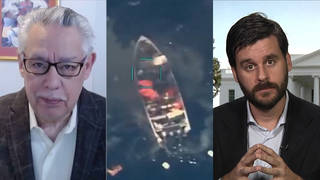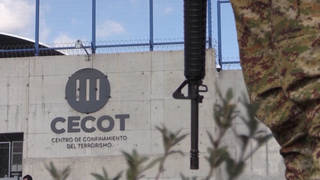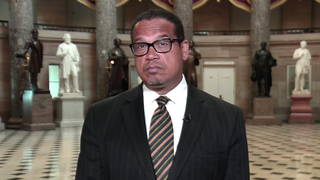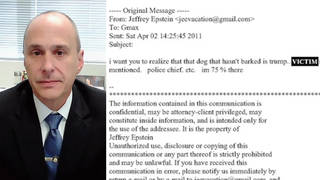
Guests
- Dallas Goldtoothorganizer with the Indigenous Environmental Network.
We continue our look back at Democracy Now!'s coverage of the ongoing standoff at Standing Rock in North Dakota, where thousands of Native American water defenders are resisting the construction of the $3.8 billion Dakota Access pipeline. In recent months, the repression against the water protectors—and journalists covering the movement—has continued to intensify. The state of North Dakota has approved $10 million to police the ongoing protest, and Morton County Sheriff Kyle Kirchmeier has called in hundreds of deputies from neighboring states. North Dakota Governor Jack Dalrymple has also activated the National Guard. Riot police with military-grade equipment have attacked the Native American protectors with pepper spray, tear gas, bean bag rounds, rubber bullets and sound cannons called LRADs—that's a long-range acoustic device. Water protectors also report near-constant surveillance from police planes and helicopters. Over 400 people have been arrested during the ongoing protests, and many report being subjected to strip searches while in the Morton County jail in North Dakota. On October 31, we spoke with Dakota and Dine activist Dallas Goldtooth of the Indigenous Environmental Network about a violent police raid on a frontline camp established at the site of the same sacred tribal burial ground where unlicensed Dakota Access security guards attacked Native Americans with dogs and pepper spray on September 3.
Transcript
AMY GOODMAN: This is Democracy Now!, democracynow.org, The War and Peace Report. I’m Amy Goodman. Today we’re looking at the ongoing standoff at Standing Rock in North Dakota, where thousands of Native American water defenders and their non-Native allies are resisting the construction of the Dakota Access pipeline.
Well, in recent months, the repression against the water protectors and journalists covering the movement has continued to intensify. The state of North Dakota has approved $10 million to police the ongoing protest, and Morton County Sheriff Kyle Kirchmeier has called in hundreds of deputies from neighboring states. North Dakota Governor Jack Dalrymple has also activated the National Guard. Riot police with military-grade equipment have attacked the Native American protectors with pepper spray, tear gas, bean bag rounds, rubber bullets and sound cannons, called LRADs—that’s long-range acoustic device. Water protectors also report near-constant surveillance from police planes and helicopters. Over 400 people have been arrested so far, and many report being subjected to strip searches while in the Morton County jail in North Dakota.
Well, on October 31st, we spoke with Dakota and Dine Nation activist Dallas Goldtooth of the Indigenous Environmental Network about a violent police raid on a frontline camp established at the site of the same sacred tribal burial ground where unlicensed Dakota Access security guards attacked Native Americans with dogs and pepper spray on September 3rd. Dallas Goldtooth began by telling us about shocking video footage that emerged from the day of the raid of a man who worked with the Dakota Access pipeline. He was a pipeline guard. But he was wearing a bandana covering his face, carrying a rifle, apparently attempting to infiltrate a group of water protectors.
DALLAS GOLDTOOTH: Thanks for having me on, Amy.
That moment, I was there when that—when this gunman, you know, was cornered into the middle of this pond nearby. And it was a very terrifying moment for a lot of us watching, I mean, to see this man pointing an assault rifle at our water protectors. And I think that—many blessings and gratitude to some of the military veterans within our security from within our Oceti Sakowin camp, who stepped up to negotiate and to de-escalate this man, to really talk to him to make sure that he did not hurt anybody, until the Bureau of Indian Affairs police officers could show up.
You know, your description is accurate. Individuals, our security teams on the ground noticed this man driving erratically, driving at high speeds through a crowded street—through the crowded highway. And they did their very best to incapacitate the vehicle and did their very best to de-escalate the situation, which they were successful in doing.
AMY GOODMAN: Explain—
DALLAS GOLDTOOTH: I think that—
AMY GOODMAN: Explain who you understand he is.
DALLAS GOLDTOOTH: I mean, it’s pretty straightforward. I mean, we found three—two documents that listed him as a Dakota Access worker. And he, himself, as I’ve understood, to even our security, stated that he worked for Dakota Access. And so, it was pretty straightforward. And I think that he’s a security contractor that has been hired by Dakota Access to guard its equipment, from what I believe, or at least to protect, you know, the workers or whatever it may be.
I think that it’s pretty terrifying to know that there—that Dakota Access has infiltrators within our camp, is paying for individuals like this, armed individuals, to create situations of escalation, potentially creating very, very dangerous situations by—you know, we don’t know what his intention could have been. He could have, you know, fired upon police, creating a situation where the police think it’s coming from our protectors when it’s not. I mean, it goes hand in hand with this series of mysterious situations that really paints—creates a situation where we have to feel suspicious about what Dakota Access’s intentions are. And it just clearly paints that Dakota Access has no regard for common decency or any kind of corporate responsibility. And it’s really surprising that people are still invested in this company.
AMY GOODMAN: Has Dakota Access pipeline responded to this video?
DALLAS GOLDTOOTH: From what I understand, the initial response from Dakota Access is that they state that this individual does not work for Dakota Access, even though he had clear identification as a Dakota Access worker.
AMY GOODMAN: I mean, it said—you see the ID. It says Kyle Thompson. Is that right?
DALLAS GOLDTOOTH: Yes, yes. His name is on it. The insurance found in the truck is—belongs to Dakota Access. You know, he has an ID card with DAPL written on it. I mean, how much more evidence do you need?
AMY GOODMAN: Right. And did he say what his intentions were, as people surrounded him, as the police, the Bureau of Indian Affairs police, arrested him?
DALLAS GOLDTOOTH: There’s a variety of accounts, but it was—from what I understood, that was told to me, that he was tasked with also identifying and being within the crowd, watching internally with the crowd, and that there was some suggestion that he might—he might have been tasked with instigating some sort of violence from within the crowd and to garner a reaction from law enforcement. I mean, that’s just what I’ve heard from different folks that were talking with him in that moment to de-escalate the situation.
AMY GOODMAN: Now, if you could talk about the fire that was set, where did it happen and what you understand was its origin?
DALLAS GOLDTOOTH: No, this happened last night. This was a—or two nights ago. It was just to the immediate west of the Oceti Sakowin camp across Highway 1806. There was some mysterious incident of a vehicle that came out of nowhere, that was almost acting as a distraction, was making a—spinning doughnuts in the middle of the road, and then it sped off to the south. And immediately after that, flames were seen on top of the hill to the west. There was a lot of—there’s documented footage that what appears to be a drip line, which is a—from what I understand, is a technique used in firefighting. I mean, it was very, very clear that that brush fire that happened was an act of arson by unknown individuals. But given the recent events with the Dakota Access worker, given the escalation of law enforcement, that, you know, a lot of fingers are pointing towards Dakota Access that—as being a culprit behind this late fire. And thank God that the wind was pushing away from the camp. The fire spread pretty large.
And the thing that’s most disturbing to me is this, Amy, is that when—on October 27th, when the police attacked our peaceful protectors at the frontline treaty camp, the excuse they used to move upon that camp was so that they could clear a barricade that we set up, a temporary barricade that we set up, so that emergency services could be delivered to the Oceti Sakowin camp, our main camp. Now, their reason for moving on, using rubber bullets and pepper spray and concussion grenades upon our water protectors was so that they could deliver—have access to deliver emergency services, ambulances and fire equipment, if needed, to the main camp. So, why is it that a number of days later, when a fire actually does happen, they refuse—the Morton County Sheriff ignores the calls and pleas for help and does not send any ambulances or fire trucks to the place that they stated that they need to get to? Why is it that there was no delivery of any kind of services until six hours later by the National Guard, who brought in a helicopter to drop water on a fire that had at that point already been put out? Why is it that Bureau of Indian Affairs officers, who were on site with medical emergency service, with firefighting equipment, who were not allowed to combat that fire without explicit permission from Morton County, they never received that permission? They asked. Morton County never gave them the permission to fight that fire. They just let it burn. I mean, there’s—it’s obvious collusion between Morton County and the Dakota Access pipeline. And that collusion is causing a very, very dangerous situation for our water protectors and for the main camp, that houses women, children, elders and just people that care and love for the land and are there for one sole purpose: to protect the water.
AMY GOODMAN: Dallas, we got word that a horse had to be put down after being shot with rubber bullets by police. Is this true?
DALLAS GOLDTOOTH: This is true. When the police moved ahead to clear out the frontline camp to the far east, a number of our warriors, our horseback riders—actually, it was a really beautiful moment, is—we had a wall of police, backed by armored personnel carriers, and there was Humvees up on the hill with snipers on top of them aimed at our water protectors. And we were being pushed back, and batons are being swung, cracking over the heads and arms of our water protectors. And then we looked to the east, and over the hills to the east comes a herd of a couple hundred buffalo, bison, roaming, like stampeding towards the police line. And it was like a beautiful moment, because people saw this herd of buffalo, and this like cheer came up from the crowd, because it was like this—like almost like that our—that we were—our fight was being recognized by the four-legged nation of the bison. And immediately behind them came some horseback riders, some young riders, men and women, who were actually guiding these buffalo towards the police line in an act of resistance and defiance.
The police immediately responded by using—flying a helicopter extremely low. They were like flying like 30 feet off the ground to scare the buffalo off. And then they deployed ATVs to attack the horseback riders. They were shot with rubber bullets. They were shot—there was concussion grenades that were fired at the horseback riders. One of the horseback riders was pulled off their horse. And sadly, one horse was injured so badly by the police that it had to be put down. And so, we—those horseback riders have since been honored and have been given war deeds and recognized as warriors and have been given honors as warriors because of the deeds that they did that day.
AMY GOODMAN: Dallas, before you go, can you give us the overall context of why—what happened on Thursday and Friday, why the escalated police presence, the roadblocks, the MRAP, the LRAD, you know, the sound cannons, the armored vehicles? What is taking place now? Where is the building of the pipeline happening? And has, as the Standing Rock Sioux tribal chair, Dave Archambault, said on Democracy Now! Friday—has the—asked, called for the Justice Department to intervene to stop the pipeline from moving forward?
DALLAS GOLDTOOTH: We haven’t heard any response from the Department of Justice to intervene to protect our civil rights on the ground as water protectors. There’s been silence on that end.
And right now, we’re in a dire situation, Amy. Like, the pipeline is literally within miles of the Missouri River. I mean, they can’t—at this point, cannot cross the Missouri River. But we need to do everything in our power to keep it from getting to that place. And so, in that—with that at heart, we had established a frontline camp, a treaty camp, right on the Dakota Access easement, on Dakota Access—what they call their own land, but really is our land as Oceti Sakowin people. We enacted a form of eminent domain, claiming the land back for ourselves as Oceti Sakowin folks. And we set up a beautiful encampment on that piece of property, which severely threatened Dakota Access, and, obviously, Morton County sheriff, for their intents to build this pipeline. And so they came in with a large force. And you described, you know, a lot of the equipment that was there. And it was terrifying. I mean, we had elders, women and children who were put at severe risk because of the actions of law enforcement.
A lot of folks know the Ponca leader Casey Camp. She stood in defiance, in peaceful prayer, in front of an armored personnel carrier, because she loved the land and wanted to protect the Missouri River, not just for the Standing Rock Sioux Nation, but for all nations and all people and the millions of people who depend on the Missouri River for drinking water. So this movement is not founded out of hate for the police officers or for the workers themselves, but out of love for the land and for all of us as human beings. That’s why we’re there. That’s not—our enemy is not the worker. Our enemy is not the police. It’s the corporations that are hell-bent on poisoning Mother Earth and disconnecting ourselves even further from the sacred integrity of the land and the water.
AMY GOODMAN: That’s Dallas Goldtooth of the Dakota and Dine Nations. He works with the Indigenous Environmental Network. Special thanks to Laura Gottesdiener, John Hamilton and Denis Moynihan. To view all our coverage of the Dakota Access pipeline resistance and the standoff at Standing Rock, go to democracynow.org.












Media Options